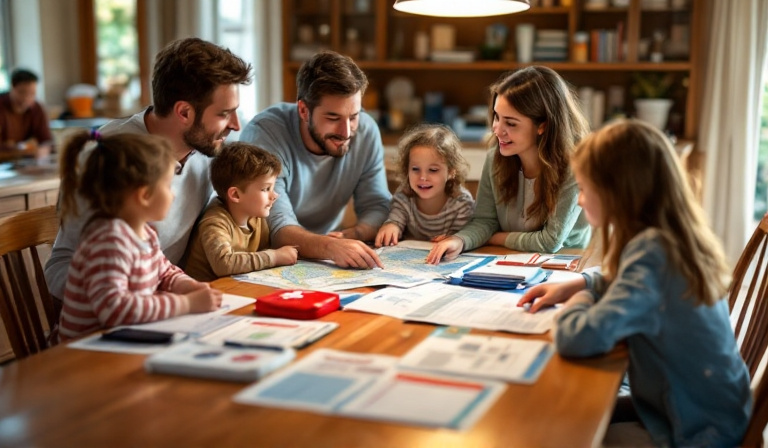
When it comes to ensuring the safety of your loved ones, having a well-structured family safety plan is crucial. Emergencies can strike without warning, and being prepared can make all the difference. Whether it’s a natural disaster, a fire, or any other unforeseen event, having a plan in place can help mitigate fear and chaos. Here’s how you can create a comprehensive family safety plan that will keep your family safe and prepared.
Understanding the Importance of a Family Safety Plan
Many families underestimate the likelihood of emergencies affecting them. However, disasters are unpredictable and can happen to anyone at any time. A family safety plan serves multiple purposes:
- Reduced Panic: Knowing what to do in an emergency reduces panic and confusion.
- Quick Response: A clear plan allows for a faster response, which can save lives.
- Peace of Mind: Being prepared offers peace of mind, knowing that you’ve done your best to protect your family.
Steps to Building a Family Safety Plan
Creating a family safety plan involves several key steps. Here’s a practical guide to help you get started:
1. Identify Potential Risks
Begin by identifying the types of emergencies most likely to affect your area. This could be natural disasters such as earthquakes, floods, or tornadoes, or man-made emergencies like fires or gas leaks. Understanding these risks will help tailor your safety plan accordingly.
2. Create an Emergency Contact List
Compile a list of emergency contacts, including local emergency services, family members, and neighbors. Ensure every family member knows how to access this list. It's also wise to include contacts who live outside your immediate area in case local lines are down.
3. Designate Meeting Points
Decide on both immediate and larger-scale meeting points. The immediate meeting point should be a safe location close to your home, like a neighbor’s house. A larger-scale meeting point could be a community center or another safe location outside your neighborhood.
4. Establish Communication Plans
Discuss how you will communicate during an emergency. Text messages often go through when calls cannot. Consider using a group messaging app that works even with low bandwidth. Also, decide on a contact person outside your area whom everyone can check in with.
5. Plan for Different Scenarios
Each emergency requires a different response. For instance, in a fire, your plan should include escape routes and a designated meeting spot outside. For natural disasters, know whether to stay put or evacuate. Run through these scenarios with your family.
Conducting Drills: Practice Makes Perfect
Once your plan is in place, practice it regularly. Conducting drills helps reinforce the plan and identify any weaknesses or areas for improvement.
1. Fire Drills
Conduct fire drills at least twice a year. Practice evacuating the house quickly and meeting at the designated spot. Ensure everyone knows how to stop, drop, and roll in case of clothing catching fire.
2. Natural Disaster Drills
Depending on your area, practice drills for earthquakes, tornadoes, or hurricanes. Teach children how to duck and cover, or where to find the safest place in the house.
3. Update and Review
Regularly review and update your plan. Changes in your family structure, such as new members or moving to a new home, will require adjustments to your safety plan.
Equipping Your Home for Safety
Part of being prepared is ensuring your home is equipped to handle emergencies. Here’s how to enhance your home safety:
1. Emergency Kits
Prepare emergency kits for your home, car, and workplace. Kits should include water, non-perishable food, first-aid supplies, flashlights, batteries, and a multi-tool. Tailor the kits to meet the specific needs of your family.
2. Smoke and Carbon Monoxide Detectors
Ensure your home is equipped with working smoke and carbon monoxide detectors. Test them monthly and replace batteries as needed. These devices offer essential early warnings, giving you more time to evacuate.
3. Secure Heavy Furniture
In earthquake-prone areas, secure heavy furniture to walls to prevent them from tipping over. This can prevent injuries and make evacuation routes safer.
Involving Children in Safety Planning
Children should be actively involved in the family safety plan. Educate them about the importance of the plan and teach them age-appropriate safety measures.
1. Teach Emergency Numbers
Ensure children know how to dial emergency numbers and what information to provide. Role-play scenarios where they may need to call for help.
2. Use Games and Activities
Turn learning into a game by using role-play and interactive activities. This can make the process less intimidating and more engaging for younger children.
Conclusion
Building a family safety plan is an investment in your family’s well-being. By identifying potential risks, establishing clear communication, and conducting regular drills, you can ensure that your family is well-prepared for any emergency. Remember, safety planning is a continuous process that evolves with your family’s needs and circumstances. By staying proactive, you contribute significantly to the safety and security of your loved ones.

